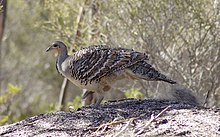Mallee fowl
| Malleefowl | |
|---|---|
 |
|
| In Ongerup, Western Australia | |
| Scientific classification | |
| Kingdom: | Animalia |
| Phylum: | Chordata |
| Class: | Aves |
| Order: | Galliformes |
| Family: | Megapodiidae |
| Genus: | Leipoa |
| Species: | L. ocellata |
| Binomial name | |
|
Leipoa ocellata Gould, 1840 |
|
The malleefowl (Leipoa ocellata) is a stocky ground-dwelling Australian bird about the size of a domestic chicken (to which it is distantly related). They are notable for the large nesting mounds constructed by the males and lack of parental care after the chicks hatch. It is the only living representative of the genus Leipoa, though the extinct giant malleefowl was a close relative.
Malleefowl are shy, wary, solitary birds that usually fly only to escape danger or reach a tree to roost in. Although very active, they are seldom seen as they freeze if disturbed, relying on their intricately patterned plumage to render them invisible, or else fade silently and rapidly into the undergrowth (flying away only if surprised or chased). They have many tactics to run away from predators.
Pairs occupy a territory but usually roost and feed apart: their social behavior is sufficient to allow regular mating during the season and little else.
In winter, the male selects an area of ground, usually a small open space between the stunted trees of the mallee, and scrapes a depression about 3 m (9.8 ft) across and just under 1 m (3.3 ft) deep in the sandy soil by raking backwards with his feet. In late winter and early spring, he begins to collect organic material to fill it with, scraping sticks, leaves and bark into wind-rows for up to 50 m (160 ft) around the hole, and building it into a nest-mound, which usually rises to about 0.6 m (2.0 ft) above ground level. The amount of litter in the mound varies, it may be almost entirely organic material, mostly sand, or anywhere in between.
After rain, he turns and mixes the material to encourage decay and, if conditions allow, digs an egg chamber in August (the last month of the southern winter). The female sometimes assists with the excavation of the egg chamber, and the timing varies with temperature and rainfall. The female usually lays between September and February, provided there has been enough rain to start organic decay of the litter. The male continues to maintain the nest-mound, gradually adding more soil to the mix as the summer approaches (presumably to regulate the temperature).
...
Wikipedia

